Marketing Intelligence Report
VerifiedAdded on 2019/12/03
|13
|3896
|177
Report
AI Summary
This marketing intelligence report provides a detailed analysis of Primark's market position. It examines the stages of the purchase decision-making process, relevant buyer behavior theories, and factors influencing consumer choices. The report explores various market research techniques, including primary and secondary data sources, and assesses the reliability and validity of research findings. A market research plan is outlined, followed by an assessment of market trends, competitor analysis (focusing on Primark GB), and an identification of organizational opportunities and threats. Techniques for assessing customer response, including a customer satisfaction survey (included in the appendix), are discussed, along with a review of the survey's success. The report concludes by summarizing Primark's approach to innovation and modification in product offerings, emphasizing customer satisfaction and market analysis.

Marketing Intelligence
Paraphrase This Document
Need a fresh take? Get an instant paraphrase of this document with our AI Paraphraser
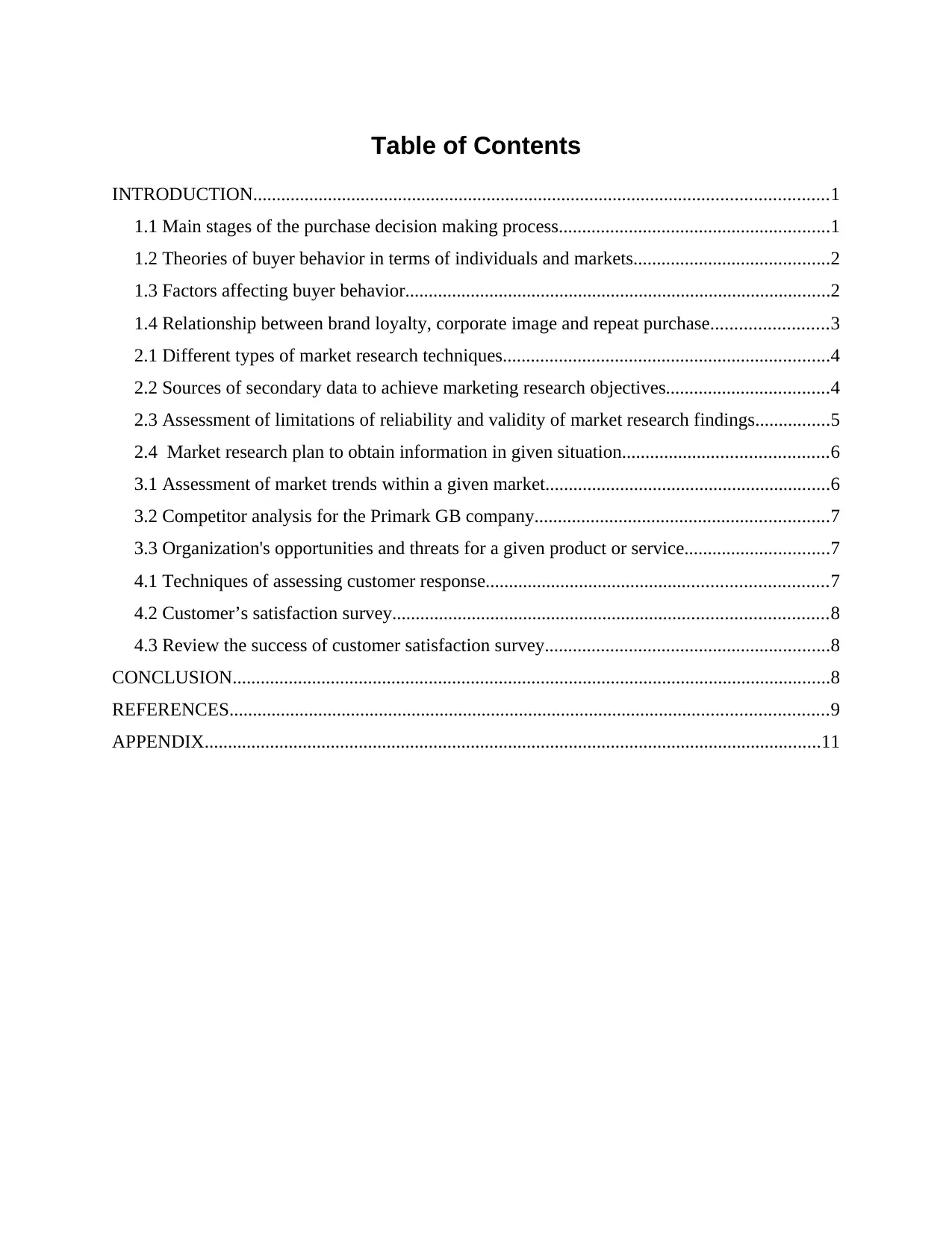
Table of Contents
INTRODUCTION...........................................................................................................................1
1.1 Main stages of the purchase decision making process..........................................................1
1.2 Theories of buyer behavior in terms of individuals and markets..........................................2
1.3 Factors affecting buyer behavior...........................................................................................2
1.4 Relationship between brand loyalty, corporate image and repeat purchase.........................3
2.1 Different types of market research techniques......................................................................4
2.2 Sources of secondary data to achieve marketing research objectives...................................4
2.3 Assessment of limitations of reliability and validity of market research findings................5
2.4 Market research plan to obtain information in given situation............................................6
3.1 Assessment of market trends within a given market.............................................................6
3.2 Competitor analysis for the Primark GB company...............................................................7
3.3 Organization's opportunities and threats for a given product or service...............................7
4.1 Techniques of assessing customer response.........................................................................7
4.2 Customer’s satisfaction survey.............................................................................................8
4.3 Review the success of customer satisfaction survey.............................................................8
CONCLUSION................................................................................................................................8
REFERENCES................................................................................................................................9
APPENDIX....................................................................................................................................11
INTRODUCTION...........................................................................................................................1
1.1 Main stages of the purchase decision making process..........................................................1
1.2 Theories of buyer behavior in terms of individuals and markets..........................................2
1.3 Factors affecting buyer behavior...........................................................................................2
1.4 Relationship between brand loyalty, corporate image and repeat purchase.........................3
2.1 Different types of market research techniques......................................................................4
2.2 Sources of secondary data to achieve marketing research objectives...................................4
2.3 Assessment of limitations of reliability and validity of market research findings................5
2.4 Market research plan to obtain information in given situation............................................6
3.1 Assessment of market trends within a given market.............................................................6
3.2 Competitor analysis for the Primark GB company...............................................................7
3.3 Organization's opportunities and threats for a given product or service...............................7
4.1 Techniques of assessing customer response.........................................................................7
4.2 Customer’s satisfaction survey.............................................................................................8
4.3 Review the success of customer satisfaction survey.............................................................8
CONCLUSION................................................................................................................................8
REFERENCES................................................................................................................................9
APPENDIX....................................................................................................................................11
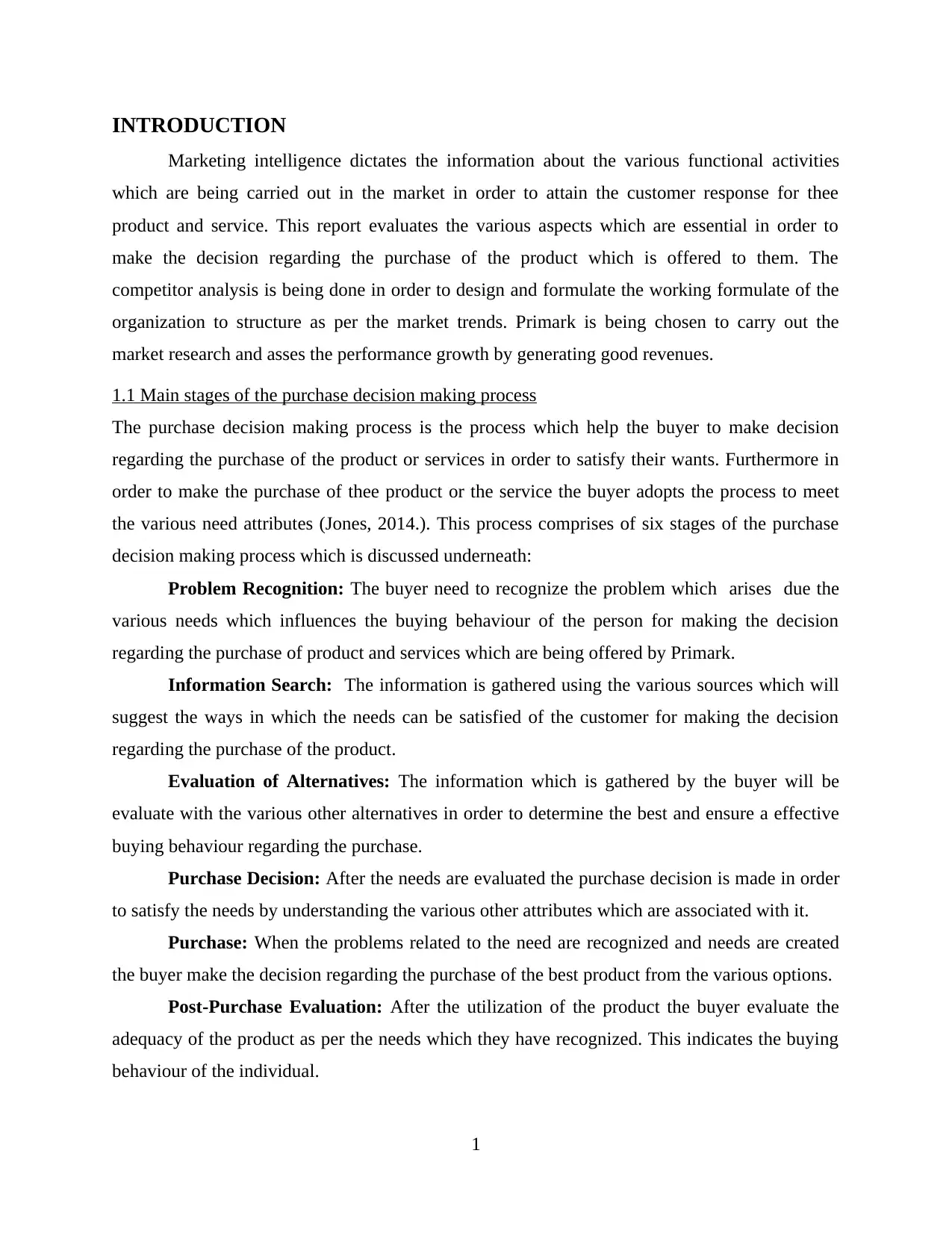
INTRODUCTION
Marketing intelligence dictates the information about the various functional activities
which are being carried out in the market in order to attain the customer response for thee
product and service. This report evaluates the various aspects which are essential in order to
make the decision regarding the purchase of the product which is offered to them. The
competitor analysis is being done in order to design and formulate the working formulate of the
organization to structure as per the market trends. Primark is being chosen to carry out the
market research and asses the performance growth by generating good revenues.
1.1 Main stages of the purchase decision making process
The purchase decision making process is the process which help the buyer to make decision
regarding the purchase of the product or services in order to satisfy their wants. Furthermore in
order to make the purchase of thee product or the service the buyer adopts the process to meet
the various need attributes (Jones, 2014.). This process comprises of six stages of the purchase
decision making process which is discussed underneath:
Problem Recognition: The buyer need to recognize the problem which arises due the
various needs which influences the buying behaviour of the person for making the decision
regarding the purchase of product and services which are being offered by Primark.
Information Search: The information is gathered using the various sources which will
suggest the ways in which the needs can be satisfied of the customer for making the decision
regarding the purchase of the product.
Evaluation of Alternatives: The information which is gathered by the buyer will be
evaluate with the various other alternatives in order to determine the best and ensure a effective
buying behaviour regarding the purchase.
Purchase Decision: After the needs are evaluated the purchase decision is made in order
to satisfy the needs by understanding the various other attributes which are associated with it.
Purchase: When the problems related to the need are recognized and needs are created
the buyer make the decision regarding the purchase of the best product from the various options.
Post-Purchase Evaluation: After the utilization of the product the buyer evaluate the
adequacy of the product as per the needs which they have recognized. This indicates the buying
behaviour of the individual.
1
Marketing intelligence dictates the information about the various functional activities
which are being carried out in the market in order to attain the customer response for thee
product and service. This report evaluates the various aspects which are essential in order to
make the decision regarding the purchase of the product which is offered to them. The
competitor analysis is being done in order to design and formulate the working formulate of the
organization to structure as per the market trends. Primark is being chosen to carry out the
market research and asses the performance growth by generating good revenues.
1.1 Main stages of the purchase decision making process
The purchase decision making process is the process which help the buyer to make decision
regarding the purchase of the product or services in order to satisfy their wants. Furthermore in
order to make the purchase of thee product or the service the buyer adopts the process to meet
the various need attributes (Jones, 2014.). This process comprises of six stages of the purchase
decision making process which is discussed underneath:
Problem Recognition: The buyer need to recognize the problem which arises due the
various needs which influences the buying behaviour of the person for making the decision
regarding the purchase of product and services which are being offered by Primark.
Information Search: The information is gathered using the various sources which will
suggest the ways in which the needs can be satisfied of the customer for making the decision
regarding the purchase of the product.
Evaluation of Alternatives: The information which is gathered by the buyer will be
evaluate with the various other alternatives in order to determine the best and ensure a effective
buying behaviour regarding the purchase.
Purchase Decision: After the needs are evaluated the purchase decision is made in order
to satisfy the needs by understanding the various other attributes which are associated with it.
Purchase: When the problems related to the need are recognized and needs are created
the buyer make the decision regarding the purchase of the best product from the various options.
Post-Purchase Evaluation: After the utilization of the product the buyer evaluate the
adequacy of the product as per the needs which they have recognized. This indicates the buying
behaviour of the individual.
1
⊘ This is a preview!⊘
Do you want full access?
Subscribe today to unlock all pages.

Trusted by 1+ million students worldwide
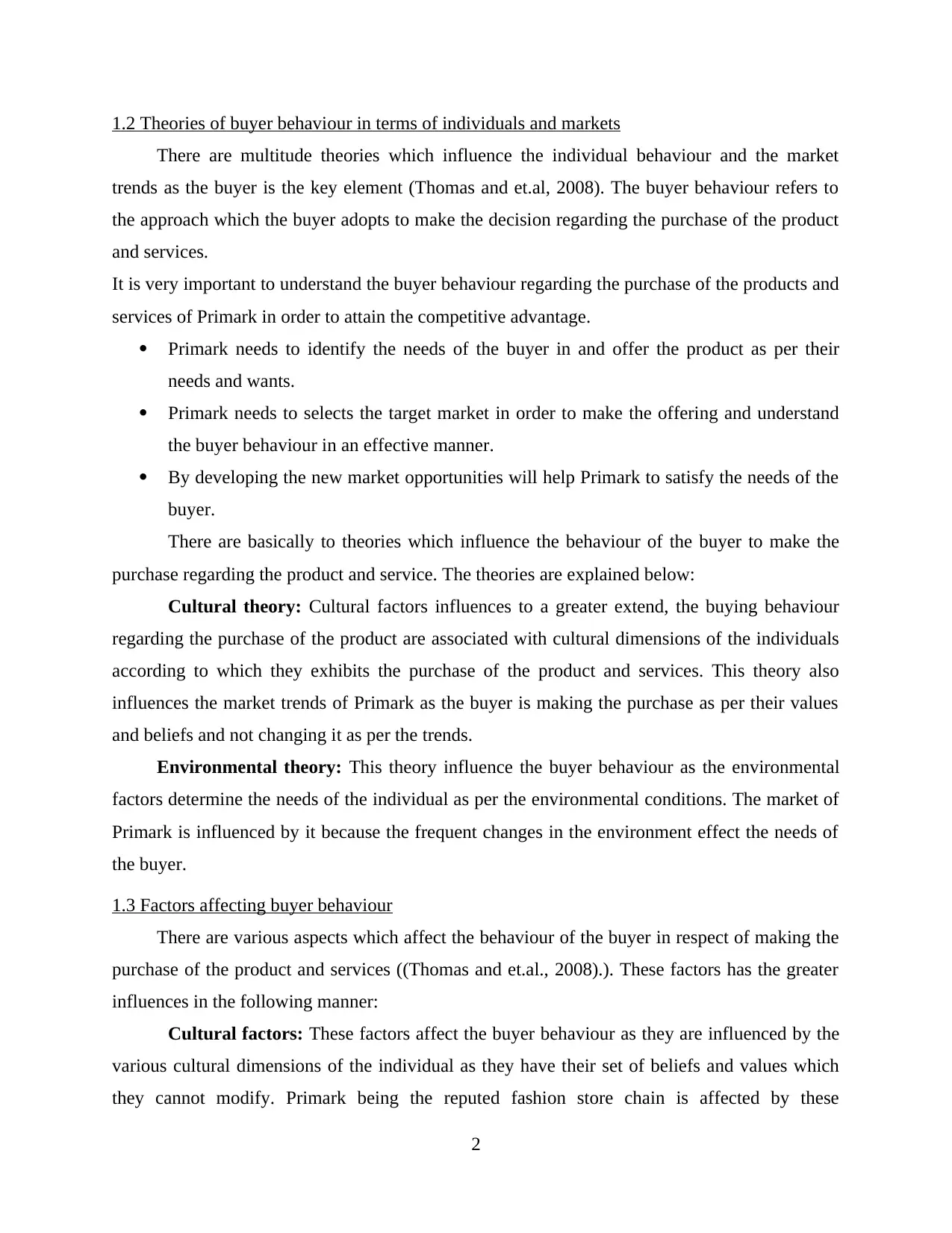
1.2 Theories of buyer behaviour in terms of individuals and markets
There are multitude theories which influence the individual behaviour and the market
trends as the buyer is the key element (Thomas and et.al, 2008). The buyer behaviour refers to
the approach which the buyer adopts to make the decision regarding the purchase of the product
and services.
It is very important to understand the buyer behaviour regarding the purchase of the products and
services of Primark in order to attain the competitive advantage.
Primark needs to identify the needs of the buyer in and offer the product as per their
needs and wants.
Primark needs to selects the target market in order to make the offering and understand
the buyer behaviour in an effective manner.
By developing the new market opportunities will help Primark to satisfy the needs of the
buyer.
There are basically to theories which influence the behaviour of the buyer to make the
purchase regarding the product and service. The theories are explained below:
Cultural theory: Cultural factors influences to a greater extend, the buying behaviour
regarding the purchase of the product are associated with cultural dimensions of the individuals
according to which they exhibits the purchase of the product and services. This theory also
influences the market trends of Primark as the buyer is making the purchase as per their values
and beliefs and not changing it as per the trends.
Environmental theory: This theory influence the buyer behaviour as the environmental
factors determine the needs of the individual as per the environmental conditions. The market of
Primark is influenced by it because the frequent changes in the environment effect the needs of
the buyer.
1.3 Factors affecting buyer behaviour
There are various aspects which affect the behaviour of the buyer in respect of making the
purchase of the product and services ((Thomas and et.al., 2008).). These factors has the greater
influences in the following manner:
Cultural factors: These factors affect the buyer behaviour as they are influenced by the
various cultural dimensions of the individual as they have their set of beliefs and values which
they cannot modify. Primark being the reputed fashion store chain is affected by these
2
There are multitude theories which influence the individual behaviour and the market
trends as the buyer is the key element (Thomas and et.al, 2008). The buyer behaviour refers to
the approach which the buyer adopts to make the decision regarding the purchase of the product
and services.
It is very important to understand the buyer behaviour regarding the purchase of the products and
services of Primark in order to attain the competitive advantage.
Primark needs to identify the needs of the buyer in and offer the product as per their
needs and wants.
Primark needs to selects the target market in order to make the offering and understand
the buyer behaviour in an effective manner.
By developing the new market opportunities will help Primark to satisfy the needs of the
buyer.
There are basically to theories which influence the behaviour of the buyer to make the
purchase regarding the product and service. The theories are explained below:
Cultural theory: Cultural factors influences to a greater extend, the buying behaviour
regarding the purchase of the product are associated with cultural dimensions of the individuals
according to which they exhibits the purchase of the product and services. This theory also
influences the market trends of Primark as the buyer is making the purchase as per their values
and beliefs and not changing it as per the trends.
Environmental theory: This theory influence the buyer behaviour as the environmental
factors determine the needs of the individual as per the environmental conditions. The market of
Primark is influenced by it because the frequent changes in the environment effect the needs of
the buyer.
1.3 Factors affecting buyer behaviour
There are various aspects which affect the behaviour of the buyer in respect of making the
purchase of the product and services ((Thomas and et.al., 2008).). These factors has the greater
influences in the following manner:
Cultural factors: These factors affect the buyer behaviour as they are influenced by the
various cultural dimensions of the individual as they have their set of beliefs and values which
they cannot modify. Primark being the reputed fashion store chain is affected by these
2
Paraphrase This Document
Need a fresh take? Get an instant paraphrase of this document with our AI Paraphraser
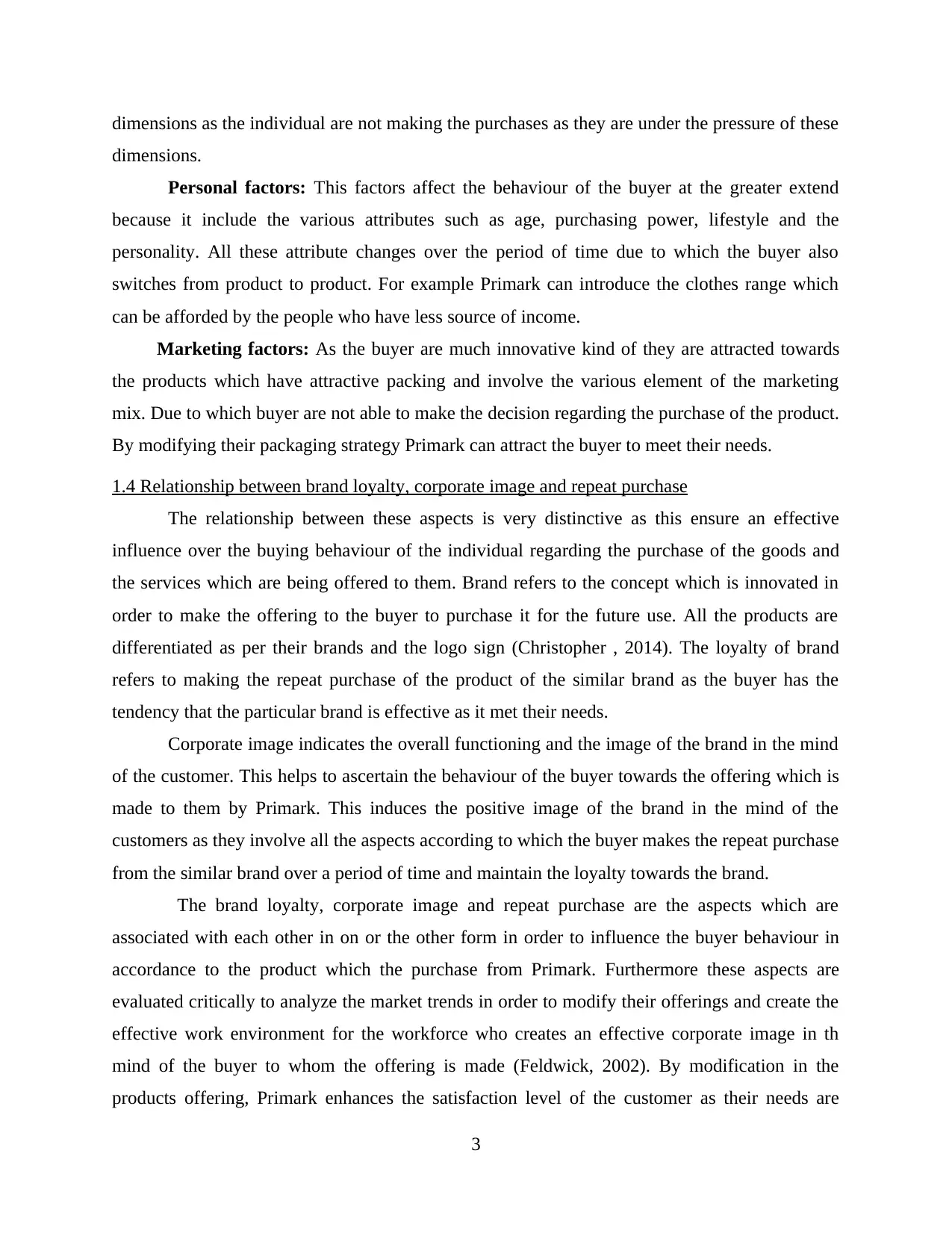
dimensions as the individual are not making the purchases as they are under the pressure of these
dimensions.
Personal factors: This factors affect the behaviour of the buyer at the greater extend
because it include the various attributes such as age, purchasing power, lifestyle and the
personality. All these attribute changes over the period of time due to which the buyer also
switches from product to product. For example Primark can introduce the clothes range which
can be afforded by the people who have less source of income.
Marketing factors: As the buyer are much innovative kind of they are attracted towards
the products which have attractive packing and involve the various element of the marketing
mix. Due to which buyer are not able to make the decision regarding the purchase of the product.
By modifying their packaging strategy Primark can attract the buyer to meet their needs.
1.4 Relationship between brand loyalty, corporate image and repeat purchase
The relationship between these aspects is very distinctive as this ensure an effective
influence over the buying behaviour of the individual regarding the purchase of the goods and
the services which are being offered to them. Brand refers to the concept which is innovated in
order to make the offering to the buyer to purchase it for the future use. All the products are
differentiated as per their brands and the logo sign (Christopher , 2014). The loyalty of brand
refers to making the repeat purchase of the product of the similar brand as the buyer has the
tendency that the particular brand is effective as it met their needs.
Corporate image indicates the overall functioning and the image of the brand in the mind
of the customer. This helps to ascertain the behaviour of the buyer towards the offering which is
made to them by Primark. This induces the positive image of the brand in the mind of the
customers as they involve all the aspects according to which the buyer makes the repeat purchase
from the similar brand over a period of time and maintain the loyalty towards the brand.
The brand loyalty, corporate image and repeat purchase are the aspects which are
associated with each other in on or the other form in order to influence the buyer behaviour in
accordance to the product which the purchase from Primark. Furthermore these aspects are
evaluated critically to analyze the market trends in order to modify their offerings and create the
effective work environment for the workforce who creates an effective corporate image in th
mind of the buyer to whom the offering is made (Feldwick, 2002). By modification in the
products offering, Primark enhances the satisfaction level of the customer as their needs are
3
dimensions.
Personal factors: This factors affect the behaviour of the buyer at the greater extend
because it include the various attributes such as age, purchasing power, lifestyle and the
personality. All these attribute changes over the period of time due to which the buyer also
switches from product to product. For example Primark can introduce the clothes range which
can be afforded by the people who have less source of income.
Marketing factors: As the buyer are much innovative kind of they are attracted towards
the products which have attractive packing and involve the various element of the marketing
mix. Due to which buyer are not able to make the decision regarding the purchase of the product.
By modifying their packaging strategy Primark can attract the buyer to meet their needs.
1.4 Relationship between brand loyalty, corporate image and repeat purchase
The relationship between these aspects is very distinctive as this ensure an effective
influence over the buying behaviour of the individual regarding the purchase of the goods and
the services which are being offered to them. Brand refers to the concept which is innovated in
order to make the offering to the buyer to purchase it for the future use. All the products are
differentiated as per their brands and the logo sign (Christopher , 2014). The loyalty of brand
refers to making the repeat purchase of the product of the similar brand as the buyer has the
tendency that the particular brand is effective as it met their needs.
Corporate image indicates the overall functioning and the image of the brand in the mind
of the customer. This helps to ascertain the behaviour of the buyer towards the offering which is
made to them by Primark. This induces the positive image of the brand in the mind of the
customers as they involve all the aspects according to which the buyer makes the repeat purchase
from the similar brand over a period of time and maintain the loyalty towards the brand.
The brand loyalty, corporate image and repeat purchase are the aspects which are
associated with each other in on or the other form in order to influence the buyer behaviour in
accordance to the product which the purchase from Primark. Furthermore these aspects are
evaluated critically to analyze the market trends in order to modify their offerings and create the
effective work environment for the workforce who creates an effective corporate image in th
mind of the buyer to whom the offering is made (Feldwick, 2002). By modification in the
products offering, Primark enhances the satisfaction level of the customer as their needs are
3
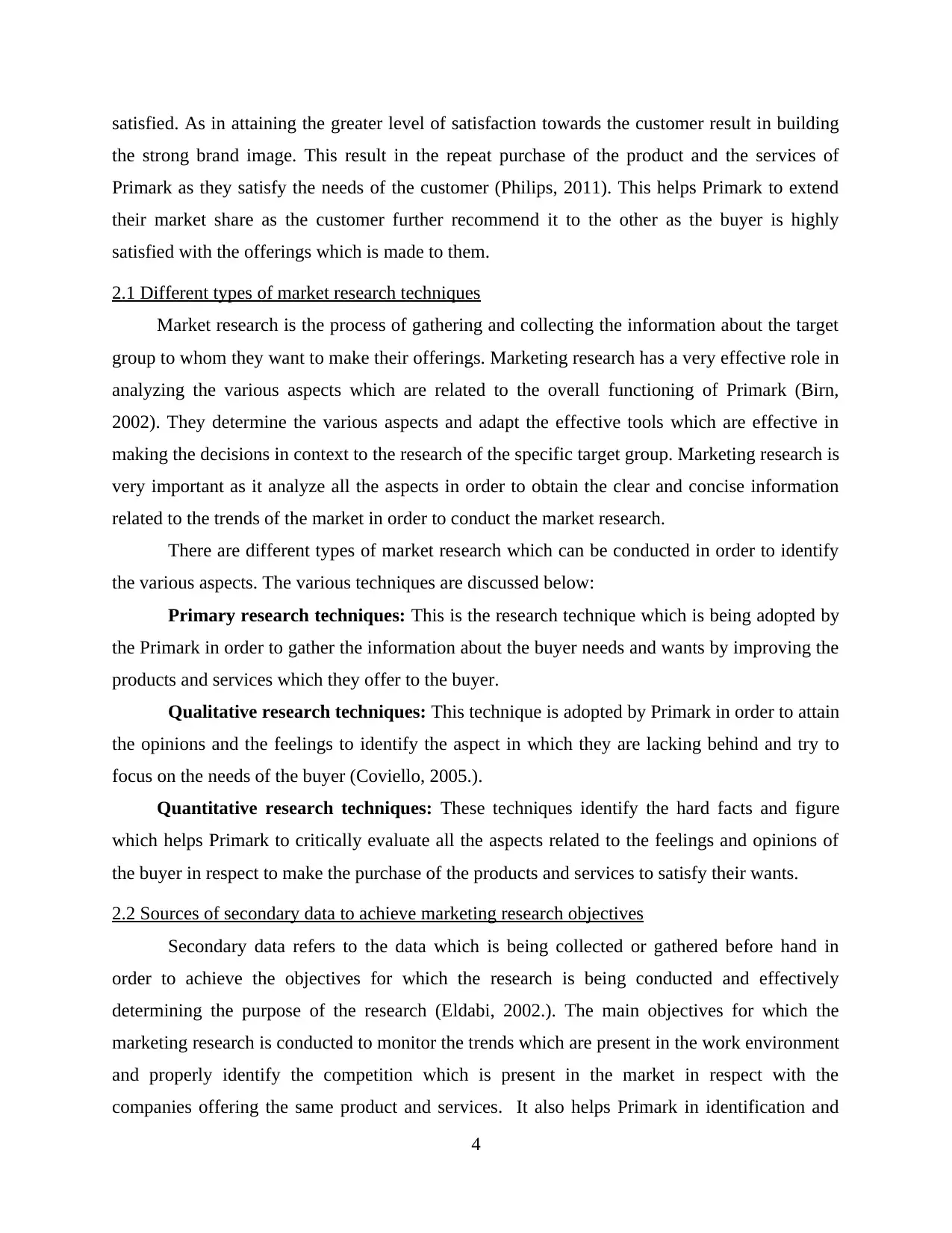
satisfied. As in attaining the greater level of satisfaction towards the customer result in building
the strong brand image. This result in the repeat purchase of the product and the services of
Primark as they satisfy the needs of the customer (Philips, 2011). This helps Primark to extend
their market share as the customer further recommend it to the other as the buyer is highly
satisfied with the offerings which is made to them.
2.1 Different types of market research techniques
Market research is the process of gathering and collecting the information about the target
group to whom they want to make their offerings. Marketing research has a very effective role in
analyzing the various aspects which are related to the overall functioning of Primark (Birn,
2002). They determine the various aspects and adapt the effective tools which are effective in
making the decisions in context to the research of the specific target group. Marketing research is
very important as it analyze all the aspects in order to obtain the clear and concise information
related to the trends of the market in order to conduct the market research.
There are different types of market research which can be conducted in order to identify
the various aspects. The various techniques are discussed below:
Primary research techniques: This is the research technique which is being adopted by
the Primark in order to gather the information about the buyer needs and wants by improving the
products and services which they offer to the buyer.
Qualitative research techniques: This technique is adopted by Primark in order to attain
the opinions and the feelings to identify the aspect in which they are lacking behind and try to
focus on the needs of the buyer (Coviello, 2005.).
Quantitative research techniques: These techniques identify the hard facts and figure
which helps Primark to critically evaluate all the aspects related to the feelings and opinions of
the buyer in respect to make the purchase of the products and services to satisfy their wants.
2.2 Sources of secondary data to achieve marketing research objectives
Secondary data refers to the data which is being collected or gathered before hand in
order to achieve the objectives for which the research is being conducted and effectively
determining the purpose of the research (Eldabi, 2002.). The main objectives for which the
marketing research is conducted to monitor the trends which are present in the work environment
and properly identify the competition which is present in the market in respect with the
companies offering the same product and services. It also helps Primark in identification and
4
the strong brand image. This result in the repeat purchase of the product and the services of
Primark as they satisfy the needs of the customer (Philips, 2011). This helps Primark to extend
their market share as the customer further recommend it to the other as the buyer is highly
satisfied with the offerings which is made to them.
2.1 Different types of market research techniques
Market research is the process of gathering and collecting the information about the target
group to whom they want to make their offerings. Marketing research has a very effective role in
analyzing the various aspects which are related to the overall functioning of Primark (Birn,
2002). They determine the various aspects and adapt the effective tools which are effective in
making the decisions in context to the research of the specific target group. Marketing research is
very important as it analyze all the aspects in order to obtain the clear and concise information
related to the trends of the market in order to conduct the market research.
There are different types of market research which can be conducted in order to identify
the various aspects. The various techniques are discussed below:
Primary research techniques: This is the research technique which is being adopted by
the Primark in order to gather the information about the buyer needs and wants by improving the
products and services which they offer to the buyer.
Qualitative research techniques: This technique is adopted by Primark in order to attain
the opinions and the feelings to identify the aspect in which they are lacking behind and try to
focus on the needs of the buyer (Coviello, 2005.).
Quantitative research techniques: These techniques identify the hard facts and figure
which helps Primark to critically evaluate all the aspects related to the feelings and opinions of
the buyer in respect to make the purchase of the products and services to satisfy their wants.
2.2 Sources of secondary data to achieve marketing research objectives
Secondary data refers to the data which is being collected or gathered before hand in
order to achieve the objectives for which the research is being conducted and effectively
determining the purpose of the research (Eldabi, 2002.). The main objectives for which the
marketing research is conducted to monitor the trends which are present in the work environment
and properly identify the competition which is present in the market in respect with the
companies offering the same product and services. It also helps Primark in identification and
4
⊘ This is a preview!⊘
Do you want full access?
Subscribe today to unlock all pages.

Trusted by 1+ million students worldwide
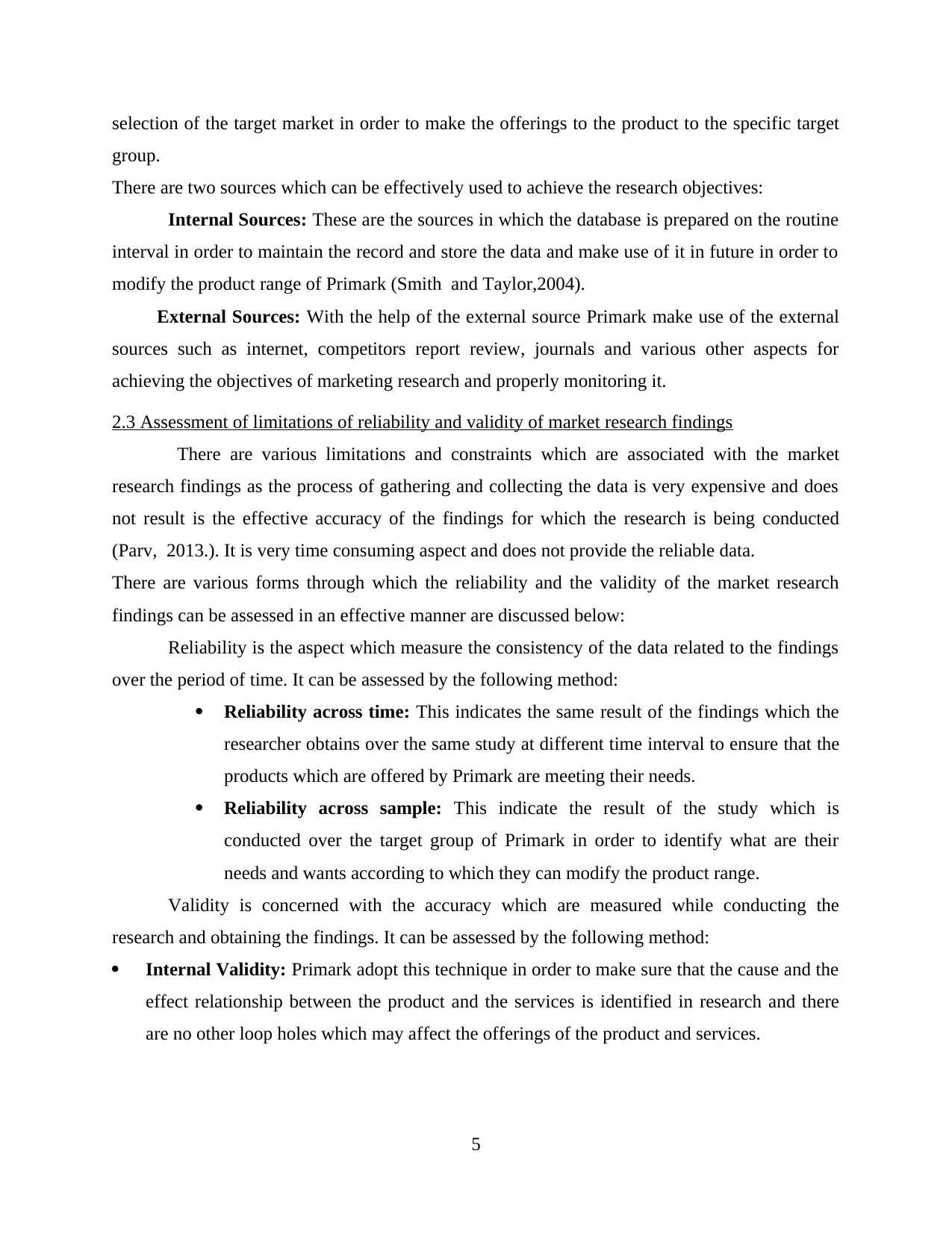
selection of the target market in order to make the offerings to the product to the specific target
group.
There are two sources which can be effectively used to achieve the research objectives:
Internal Sources: These are the sources in which the database is prepared on the routine
interval in order to maintain the record and store the data and make use of it in future in order to
modify the product range of Primark (Smith and Taylor,2004).
External Sources: With the help of the external source Primark make use of the external
sources such as internet, competitors report review, journals and various other aspects for
achieving the objectives of marketing research and properly monitoring it.
2.3 Assessment of limitations of reliability and validity of market research findings
There are various limitations and constraints which are associated with the market
research findings as the process of gathering and collecting the data is very expensive and does
not result is the effective accuracy of the findings for which the research is being conducted
(Parv, 2013.). It is very time consuming aspect and does not provide the reliable data.
There are various forms through which the reliability and the validity of the market research
findings can be assessed in an effective manner are discussed below:
Reliability is the aspect which measure the consistency of the data related to the findings
over the period of time. It can be assessed by the following method:
Reliability across time: This indicates the same result of the findings which the
researcher obtains over the same study at different time interval to ensure that the
products which are offered by Primark are meeting their needs.
Reliability across sample: This indicate the result of the study which is
conducted over the target group of Primark in order to identify what are their
needs and wants according to which they can modify the product range.
Validity is concerned with the accuracy which are measured while conducting the
research and obtaining the findings. It can be assessed by the following method:
Internal Validity: Primark adopt this technique in order to make sure that the cause and the
effect relationship between the product and the services is identified in research and there
are no other loop holes which may affect the offerings of the product and services.
5
group.
There are two sources which can be effectively used to achieve the research objectives:
Internal Sources: These are the sources in which the database is prepared on the routine
interval in order to maintain the record and store the data and make use of it in future in order to
modify the product range of Primark (Smith and Taylor,2004).
External Sources: With the help of the external source Primark make use of the external
sources such as internet, competitors report review, journals and various other aspects for
achieving the objectives of marketing research and properly monitoring it.
2.3 Assessment of limitations of reliability and validity of market research findings
There are various limitations and constraints which are associated with the market
research findings as the process of gathering and collecting the data is very expensive and does
not result is the effective accuracy of the findings for which the research is being conducted
(Parv, 2013.). It is very time consuming aspect and does not provide the reliable data.
There are various forms through which the reliability and the validity of the market research
findings can be assessed in an effective manner are discussed below:
Reliability is the aspect which measure the consistency of the data related to the findings
over the period of time. It can be assessed by the following method:
Reliability across time: This indicates the same result of the findings which the
researcher obtains over the same study at different time interval to ensure that the
products which are offered by Primark are meeting their needs.
Reliability across sample: This indicate the result of the study which is
conducted over the target group of Primark in order to identify what are their
needs and wants according to which they can modify the product range.
Validity is concerned with the accuracy which are measured while conducting the
research and obtaining the findings. It can be assessed by the following method:
Internal Validity: Primark adopt this technique in order to make sure that the cause and the
effect relationship between the product and the services is identified in research and there
are no other loop holes which may affect the offerings of the product and services.
5
Paraphrase This Document
Need a fresh take? Get an instant paraphrase of this document with our AI Paraphraser
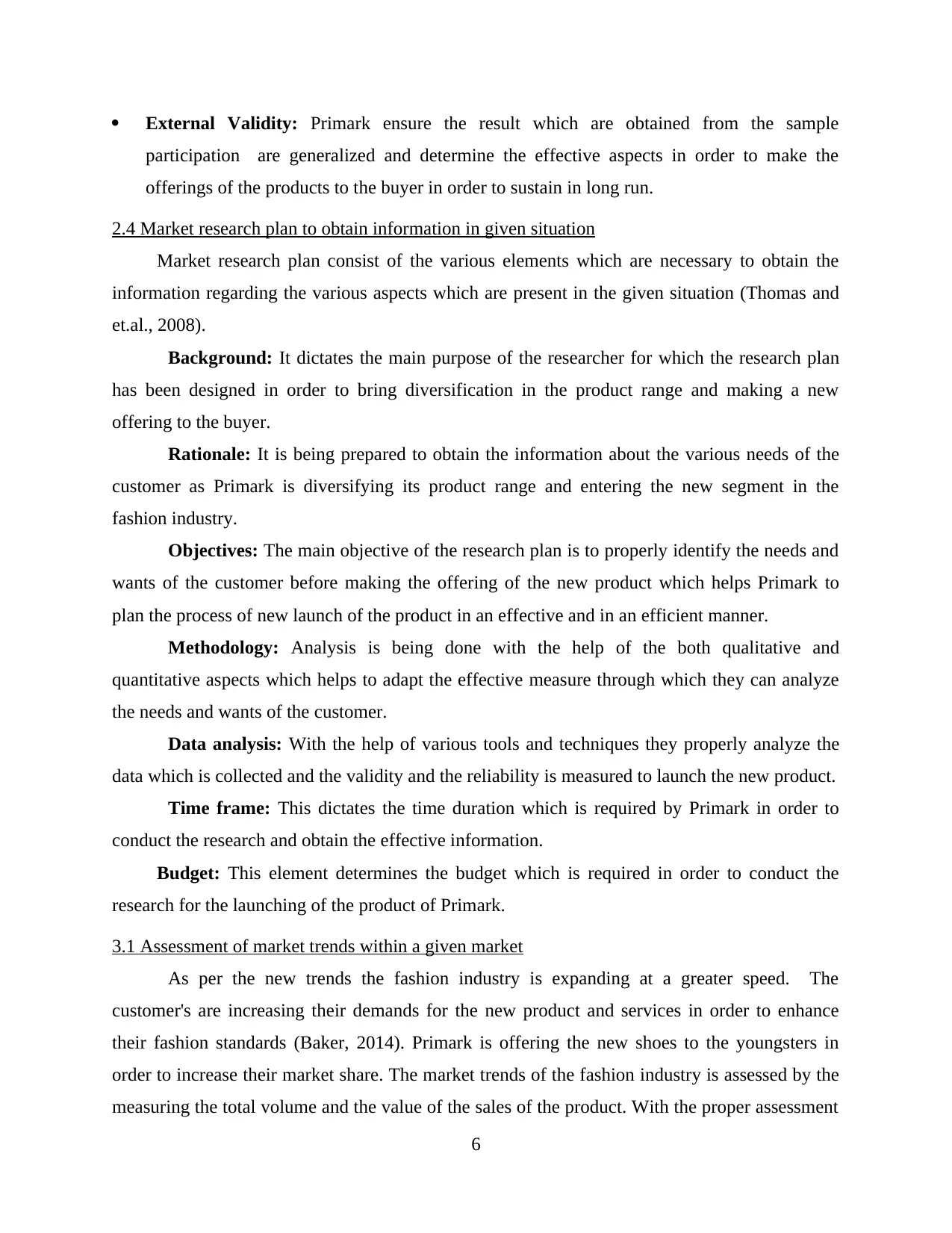
External Validity: Primark ensure the result which are obtained from the sample
participation are generalized and determine the effective aspects in order to make the
offerings of the products to the buyer in order to sustain in long run.
2.4 Market research plan to obtain information in given situation
Market research plan consist of the various elements which are necessary to obtain the
information regarding the various aspects which are present in the given situation (Thomas and
et.al., 2008).
Background: It dictates the main purpose of the researcher for which the research plan
has been designed in order to bring diversification in the product range and making a new
offering to the buyer.
Rationale: It is being prepared to obtain the information about the various needs of the
customer as Primark is diversifying its product range and entering the new segment in the
fashion industry.
Objectives: The main objective of the research plan is to properly identify the needs and
wants of the customer before making the offering of the new product which helps Primark to
plan the process of new launch of the product in an effective and in an efficient manner.
Methodology: Analysis is being done with the help of the both qualitative and
quantitative aspects which helps to adapt the effective measure through which they can analyze
the needs and wants of the customer.
Data analysis: With the help of various tools and techniques they properly analyze the
data which is collected and the validity and the reliability is measured to launch the new product.
Time frame: This dictates the time duration which is required by Primark in order to
conduct the research and obtain the effective information.
Budget: This element determines the budget which is required in order to conduct the
research for the launching of the product of Primark.
3.1 Assessment of market trends within a given market
As per the new trends the fashion industry is expanding at a greater speed. The
customer's are increasing their demands for the new product and services in order to enhance
their fashion standards (Baker, 2014). Primark is offering the new shoes to the youngsters in
order to increase their market share. The market trends of the fashion industry is assessed by the
measuring the total volume and the value of the sales of the product. With the proper assessment
6
participation are generalized and determine the effective aspects in order to make the
offerings of the products to the buyer in order to sustain in long run.
2.4 Market research plan to obtain information in given situation
Market research plan consist of the various elements which are necessary to obtain the
information regarding the various aspects which are present in the given situation (Thomas and
et.al., 2008).
Background: It dictates the main purpose of the researcher for which the research plan
has been designed in order to bring diversification in the product range and making a new
offering to the buyer.
Rationale: It is being prepared to obtain the information about the various needs of the
customer as Primark is diversifying its product range and entering the new segment in the
fashion industry.
Objectives: The main objective of the research plan is to properly identify the needs and
wants of the customer before making the offering of the new product which helps Primark to
plan the process of new launch of the product in an effective and in an efficient manner.
Methodology: Analysis is being done with the help of the both qualitative and
quantitative aspects which helps to adapt the effective measure through which they can analyze
the needs and wants of the customer.
Data analysis: With the help of various tools and techniques they properly analyze the
data which is collected and the validity and the reliability is measured to launch the new product.
Time frame: This dictates the time duration which is required by Primark in order to
conduct the research and obtain the effective information.
Budget: This element determines the budget which is required in order to conduct the
research for the launching of the product of Primark.
3.1 Assessment of market trends within a given market
As per the new trends the fashion industry is expanding at a greater speed. The
customer's are increasing their demands for the new product and services in order to enhance
their fashion standards (Baker, 2014). Primark is offering the new shoes to the youngsters in
order to increase their market share. The market trends of the fashion industry is assessed by the
measuring the total volume and the value of the sales of the product. With the proper assessment
6
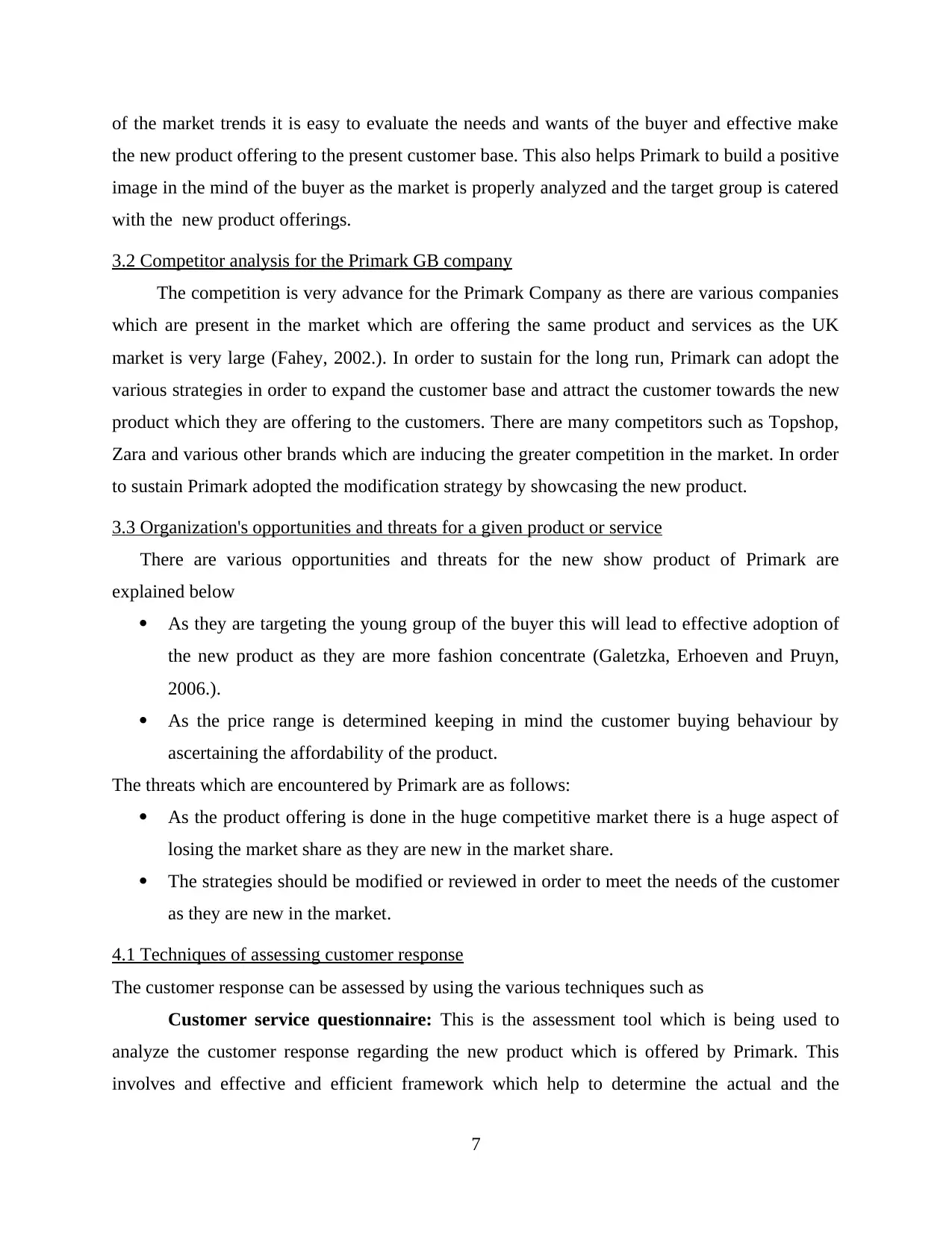
of the market trends it is easy to evaluate the needs and wants of the buyer and effective make
the new product offering to the present customer base. This also helps Primark to build a positive
image in the mind of the buyer as the market is properly analyzed and the target group is catered
with the new product offerings.
3.2 Competitor analysis for the Primark GB company
The competition is very advance for the Primark Company as there are various companies
which are present in the market which are offering the same product and services as the UK
market is very large (Fahey, 2002.). In order to sustain for the long run, Primark can adopt the
various strategies in order to expand the customer base and attract the customer towards the new
product which they are offering to the customers. There are many competitors such as Topshop,
Zara and various other brands which are inducing the greater competition in the market. In order
to sustain Primark adopted the modification strategy by showcasing the new product.
3.3 Organization's opportunities and threats for a given product or service
There are various opportunities and threats for the new show product of Primark are
explained below
As they are targeting the young group of the buyer this will lead to effective adoption of
the new product as they are more fashion concentrate (Galetzka, Erhoeven and Pruyn,
2006.).
As the price range is determined keeping in mind the customer buying behaviour by
ascertaining the affordability of the product.
The threats which are encountered by Primark are as follows:
As the product offering is done in the huge competitive market there is a huge aspect of
losing the market share as they are new in the market share.
The strategies should be modified or reviewed in order to meet the needs of the customer
as they are new in the market.
4.1 Techniques of assessing customer response
The customer response can be assessed by using the various techniques such as
Customer service questionnaire: This is the assessment tool which is being used to
analyze the customer response regarding the new product which is offered by Primark. This
involves and effective and efficient framework which help to determine the actual and the
7
the new product offering to the present customer base. This also helps Primark to build a positive
image in the mind of the buyer as the market is properly analyzed and the target group is catered
with the new product offerings.
3.2 Competitor analysis for the Primark GB company
The competition is very advance for the Primark Company as there are various companies
which are present in the market which are offering the same product and services as the UK
market is very large (Fahey, 2002.). In order to sustain for the long run, Primark can adopt the
various strategies in order to expand the customer base and attract the customer towards the new
product which they are offering to the customers. There are many competitors such as Topshop,
Zara and various other brands which are inducing the greater competition in the market. In order
to sustain Primark adopted the modification strategy by showcasing the new product.
3.3 Organization's opportunities and threats for a given product or service
There are various opportunities and threats for the new show product of Primark are
explained below
As they are targeting the young group of the buyer this will lead to effective adoption of
the new product as they are more fashion concentrate (Galetzka, Erhoeven and Pruyn,
2006.).
As the price range is determined keeping in mind the customer buying behaviour by
ascertaining the affordability of the product.
The threats which are encountered by Primark are as follows:
As the product offering is done in the huge competitive market there is a huge aspect of
losing the market share as they are new in the market share.
The strategies should be modified or reviewed in order to meet the needs of the customer
as they are new in the market.
4.1 Techniques of assessing customer response
The customer response can be assessed by using the various techniques such as
Customer service questionnaire: This is the assessment tool which is being used to
analyze the customer response regarding the new product which is offered by Primark. This
involves and effective and efficient framework which help to determine the actual and the
7
⊘ This is a preview!⊘
Do you want full access?
Subscribe today to unlock all pages.

Trusted by 1+ million students worldwide
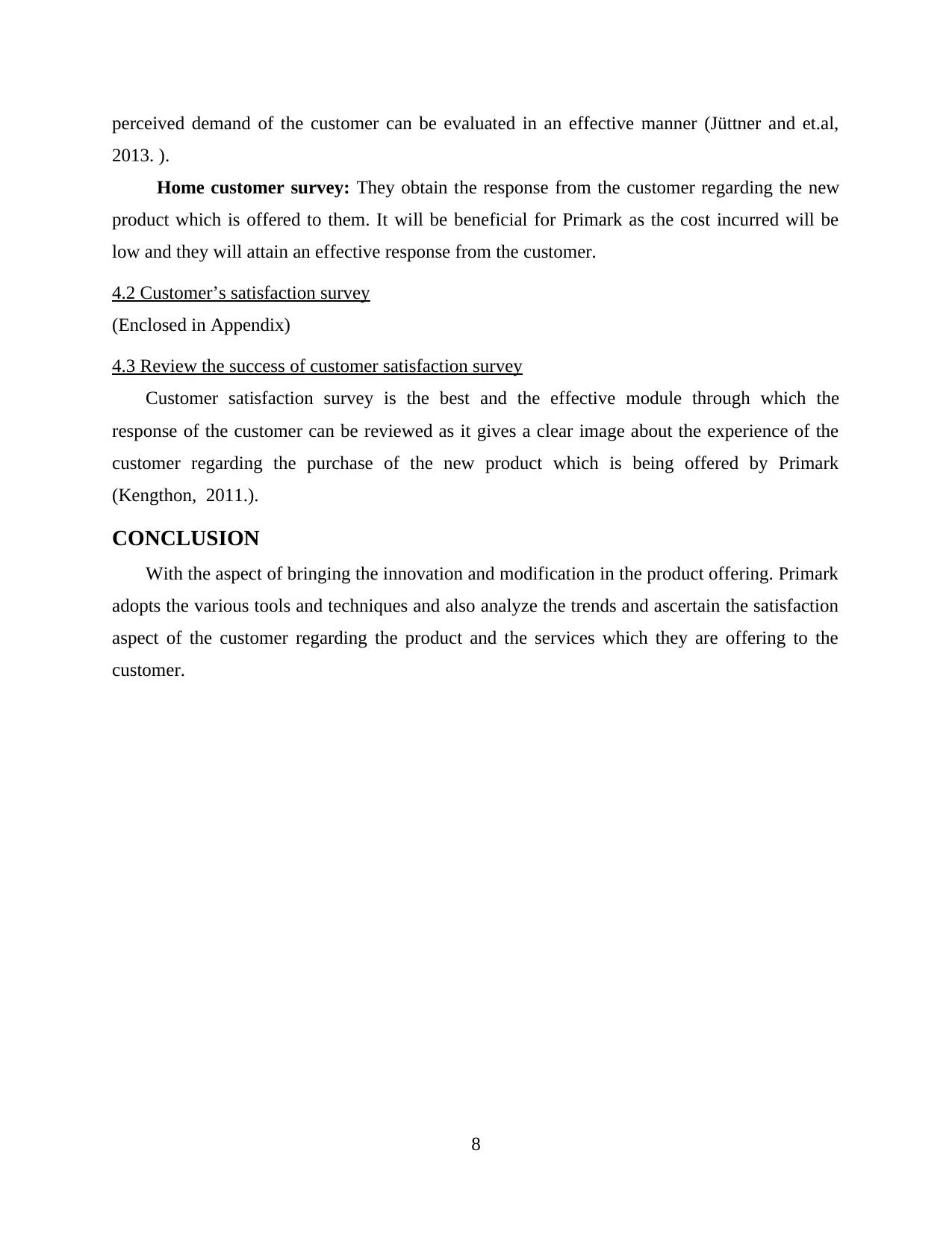
perceived demand of the customer can be evaluated in an effective manner (Jüttner and et.al,
2013. ).
Home customer survey: They obtain the response from the customer regarding the new
product which is offered to them. It will be beneficial for Primark as the cost incurred will be
low and they will attain an effective response from the customer.
4.2 Customer’s satisfaction survey
(Enclosed in Appendix)
4.3 Review the success of customer satisfaction survey
Customer satisfaction survey is the best and the effective module through which the
response of the customer can be reviewed as it gives a clear image about the experience of the
customer regarding the purchase of the new product which is being offered by Primark
(Kengthon, 2011.).
CONCLUSION
With the aspect of bringing the innovation and modification in the product offering. Primark
adopts the various tools and techniques and also analyze the trends and ascertain the satisfaction
aspect of the customer regarding the product and the services which they are offering to the
customer.
8
2013. ).
Home customer survey: They obtain the response from the customer regarding the new
product which is offered to them. It will be beneficial for Primark as the cost incurred will be
low and they will attain an effective response from the customer.
4.2 Customer’s satisfaction survey
(Enclosed in Appendix)
4.3 Review the success of customer satisfaction survey
Customer satisfaction survey is the best and the effective module through which the
response of the customer can be reviewed as it gives a clear image about the experience of the
customer regarding the purchase of the new product which is being offered by Primark
(Kengthon, 2011.).
CONCLUSION
With the aspect of bringing the innovation and modification in the product offering. Primark
adopts the various tools and techniques and also analyze the trends and ascertain the satisfaction
aspect of the customer regarding the product and the services which they are offering to the
customer.
8
Paraphrase This Document
Need a fresh take? Get an instant paraphrase of this document with our AI Paraphraser
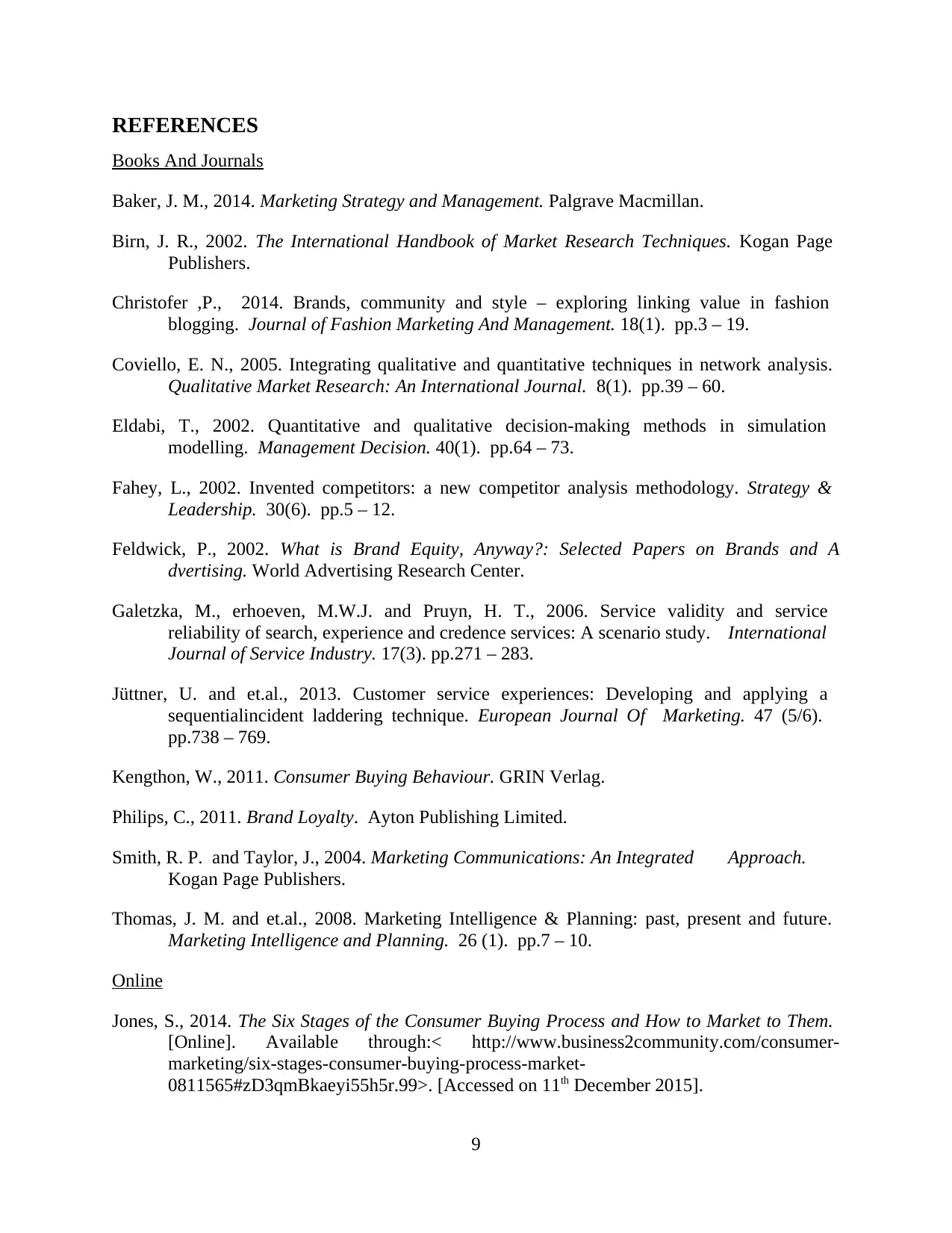
REFERENCES
Books And Journals
Baker, J. M., 2014. Marketing Strategy and Management. Palgrave Macmillan.
Birn, J. R., 2002. The International Handbook of Market Research Techniques. Kogan Page
Publishers.
Christofer ,P., 2014. Brands, community and style – exploring linking value in fashion
blogging. Journal of Fashion Marketing And Management. 18(1). pp.3 – 19.
Coviello, E. N., 2005. Integrating qualitative and quantitative techniques in network analysis.
Qualitative Market Research: An International Journal. 8(1). pp.39 – 60.
Eldabi, T., 2002. Quantitative and qualitative decision‐making methods in simulation
modelling. Management Decision. 40(1). pp.64 – 73.
Fahey, L., 2002. Invented competitors: a new competitor analysis methodology. Strategy &
Leadership. 30(6). pp.5 – 12.
Feldwick, P., 2002. What is Brand Equity, Anyway?: Selected Papers on Brands and A
dvertising. World Advertising Research Center.
Galetzka, M., erhoeven, M.W.J. and Pruyn, H. T., 2006. Service validity and service
reliability of search, experience and credence services: A scenario study. International
Journal of Service Industry. 17(3). pp.271 – 283.
Jüttner, U. and et.al., 2013. Customer service experiences: Developing and applying a
sequentialincident laddering technique. European Journal Of Marketing. 47 (5/6).
pp.738 – 769.
Kengthon, W., 2011. Consumer Buying Behaviour. GRIN Verlag.
Philips, C., 2011. Brand Loyalty. Ayton Publishing Limited.
Smith, R. P. and Taylor, J., 2004. Marketing Communications: An Integrated Approach.
Kogan Page Publishers.
Thomas, J. M. and et.al., 2008. Marketing Intelligence & Planning: past, present and future.
Marketing Intelligence and Planning. 26 (1). pp.7 – 10.
Online
Jones, S., 2014. The Six Stages of the Consumer Buying Process and How to Market to Them.
[Online]. Available through:< http://www.business2community.com/consumer-
marketing/six-stages-consumer-buying-process-market-
0811565#zD3qmBkaeyi55h5r.99>. [Accessed on 11th December 2015].
9
Books And Journals
Baker, J. M., 2014. Marketing Strategy and Management. Palgrave Macmillan.
Birn, J. R., 2002. The International Handbook of Market Research Techniques. Kogan Page
Publishers.
Christofer ,P., 2014. Brands, community and style – exploring linking value in fashion
blogging. Journal of Fashion Marketing And Management. 18(1). pp.3 – 19.
Coviello, E. N., 2005. Integrating qualitative and quantitative techniques in network analysis.
Qualitative Market Research: An International Journal. 8(1). pp.39 – 60.
Eldabi, T., 2002. Quantitative and qualitative decision‐making methods in simulation
modelling. Management Decision. 40(1). pp.64 – 73.
Fahey, L., 2002. Invented competitors: a new competitor analysis methodology. Strategy &
Leadership. 30(6). pp.5 – 12.
Feldwick, P., 2002. What is Brand Equity, Anyway?: Selected Papers on Brands and A
dvertising. World Advertising Research Center.
Galetzka, M., erhoeven, M.W.J. and Pruyn, H. T., 2006. Service validity and service
reliability of search, experience and credence services: A scenario study. International
Journal of Service Industry. 17(3). pp.271 – 283.
Jüttner, U. and et.al., 2013. Customer service experiences: Developing and applying a
sequentialincident laddering technique. European Journal Of Marketing. 47 (5/6).
pp.738 – 769.
Kengthon, W., 2011. Consumer Buying Behaviour. GRIN Verlag.
Philips, C., 2011. Brand Loyalty. Ayton Publishing Limited.
Smith, R. P. and Taylor, J., 2004. Marketing Communications: An Integrated Approach.
Kogan Page Publishers.
Thomas, J. M. and et.al., 2008. Marketing Intelligence & Planning: past, present and future.
Marketing Intelligence and Planning. 26 (1). pp.7 – 10.
Online
Jones, S., 2014. The Six Stages of the Consumer Buying Process and How to Market to Them.
[Online]. Available through:< http://www.business2community.com/consumer-
marketing/six-stages-consumer-buying-process-market-
0811565#zD3qmBkaeyi55h5r.99>. [Accessed on 11th December 2015].
9
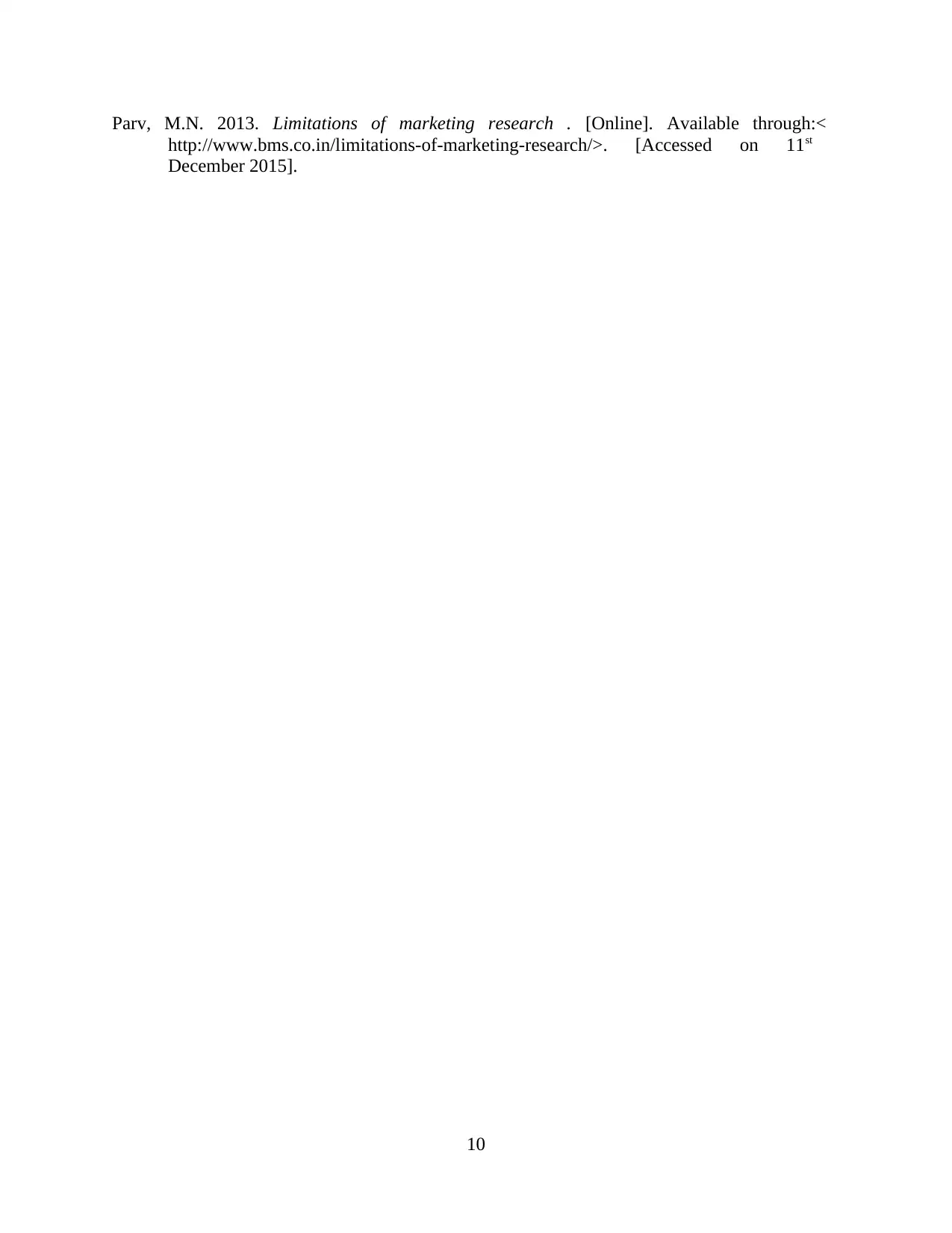
Parv, M.N. 2013. Limitations of marketing research . [Online]. Available through:<
http://www.bms.co.in/limitations-of-marketing-research/>. [Accessed on 11st
December 2015].
10
http://www.bms.co.in/limitations-of-marketing-research/>. [Accessed on 11st
December 2015].
10
⊘ This is a preview!⊘
Do you want full access?
Subscribe today to unlock all pages.

Trusted by 1+ million students worldwide
1 out of 13
Related Documents
Your All-in-One AI-Powered Toolkit for Academic Success.
+13062052269
info@desklib.com
Available 24*7 on WhatsApp / Email
![[object Object]](/_next/static/media/star-bottom.7253800d.svg)
Unlock your academic potential
Copyright © 2020–2025 A2Z Services. All Rights Reserved. Developed and managed by ZUCOL.





